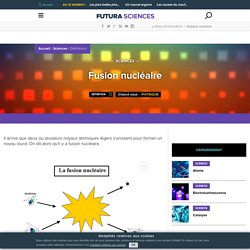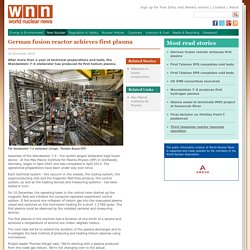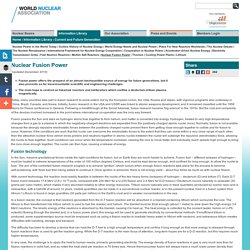

Horizons - A Slice of the Sun. That is the goal of scientists trying to create new energy sources....

That is the goal of scientists trying to create new energy sources. Nuclear power has, for a long time, been the centre of much controversy. Although it doesn’t create the pollution associated with fossil fuels, it does leave us with an almost unimaginable period of radioactive waste. Radioactive isotopes eventually decay or disintegrate into harmless materials. Some isotopes decay in hours or even minutes, but others decay very slowly.
So whilst nuclear power might provide a short term fix to pollution problems, it can also create other problems which might last longer than modern man has even existed. But a tantalising possibility has been raised by nuclear scientists to create a form of nuclear power that provides almost limitless energy with few side effects. Fusion nuclear power is a world away from the fission power we know today and it involves creating a bit of the sun right here on earth. ITER Réalité d'un projet nucléaire 1/5. Fusion nucléaire. Il arrive que deux ou plusieurs noyaux atomiques légers s'unissent pour former un noyau lourd.

On dit alors qu'il y a fusion nucléaire. La fusion nucléaire est plus difficile à réaliser que la fission car ici, il faut rapprocher des atomes si près l'un de l'autre qu'ils vont se coller. Pour cela, il est nécessaire de porter la matière à une très haute température (environ 100 millions de degrés), sous une très forte pression.
L'énergie libérée par ce phénomène est 10 fois supérieure à celle libérée lors de la fission. D'autre part, la fusion nucléaire ne produit pas de déchets radioactifs puisque les produits de fusion sont stables. Fusion contrôlée.
German fusion reactor achieves first plasma. After more than a year of technical preparations and tests, the Wendelstein 7-X stellarator has produced its first helium plasma.

Assembly of the Wendelstein 7-X - the world's largest stellarator-type fusion device - at the Max Planck Institute for Plasma Physics (IPP) in Greifswald, Germany, began in April 2005 and was completed in April 2014. The operational preparations have been under way ever since. Each technical system - the vacuum in the vessels, the cooling system, the superconducting coils and the magnetic field they produce, the control system, as well as the heating devices and measuring systems - has been tested in turn. On 10 December, the operating team in the control room started up the magnetic field and initiated the computer-operated experiment control system. It fed around one milligram of helium gas into the evacuated plasma vessel and switched on the microwave heating for a short 1.3 MW pulse.
Nuclear Fusion : WNA. (Updated December 2015) Fusion power offers the prospect of an almost inexhaustible source of energy for future generations, but it also presents so far insurmountable scientific and engineering challenges.The main hope is centred on tokamak reactors and stellarators which confine a deuterium-tritium plasma magnetically.

Today, many countries take part in fusion research to some extent, led by the European Union, the USA, Russia and Japan, with vigorous programs also underway in China, Brazil, Canada, and Korea. Initially, fusion research in the USA and USSR was linked to atomic weapons development, and it remained classified until the 1958 Atoms for Peace conference in Geneva. Milestone in fusion construction. The joining together of the first two modules of a new fusion reactor has begun at the Max Planck Institute for Plasma Physics (IPP) in Greifswald, Germany.

The Wendelstein 7-X stellarator should be complete in 2014. When joined, the two modules will together represent one fifth of the reactor's inner core of superconducting magnetic coils. They will then be fitted with a superconducting bus, cryopiping and power connections. Construction work on the next two modules has already started. When complete, Wendelstein 7-X will allow IPP researchers to study high energy plasma under stable conditions.
IPP said that the early stages of construction were "hampered by quality problems" centred on the electrical insulation of the superconducting coils and additional engineering required to improve the coil support structure. However, a revision in the construction schedule has put completion back to 2014. German fusion reactor achieves first plasma.